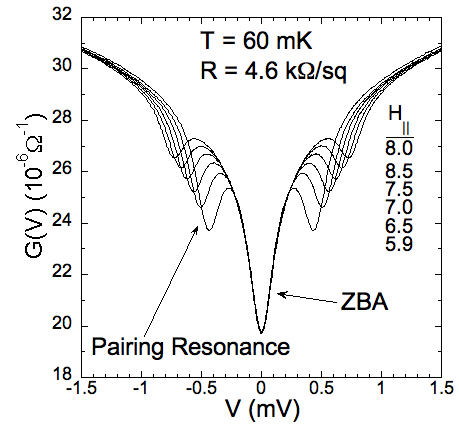Consider a thin Al film in a supercritical parallel magnetic field. The ground state of the system in the paramagnetic normal state can be represented by spin states of equal momentum as shown on the left, where Ez is the Zeeman energy. Only these states can participate in pairing. The pairing resonance is associated with evanescent Cooper pairs formed via the tunneling channel depicted by the purple spin. The resonance lies Ez above the Fermi energy, and as such, does not affect the transport properties of the film.
Though superconductivity is one of the most ubiquitous and extensively studied phenomenon in condensed matter physics, little is known about how an attractive electron-electron interaction mode, whether mediated by phonons or some more exotic coupling, evolves from a non-coherent fluctuation channel to a full-blown superconducting instability. Since the resonance represents a microscopic window into the fundamental quantum processes by which a stable Cooper pair is formed out of a specific interaction channel, a more comprehensive understanding of its dynamics has far reaching implications.

The data on the left represents the tunnling density-of-states of a 2 nm thick Al film in a number of supercritical parallel fields. The parallel critical field of this film was ~ 6 T, which agreed well with the Clogston critical field Hc|| ~ gap/sqrt(2). Note the significant depletion of states at zero bias (Fermi energy). This is the Zero Bias Anomaly which is associated e-e interactions. The satellite features are due to the pairing resonance and represent the system's attempt to form a superconducting gap near the Zeeman energy. As is evident in the figure, the resonance moves to higher energy with increasing field. The resonance can be observed in high field tunneling by virtue of the fact that it is a spin-singlet mode riding on top of a paramagnetic background.
Further reading: